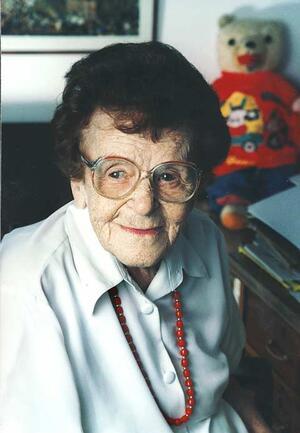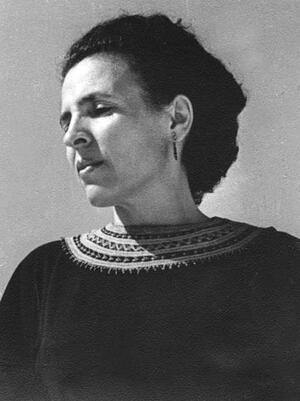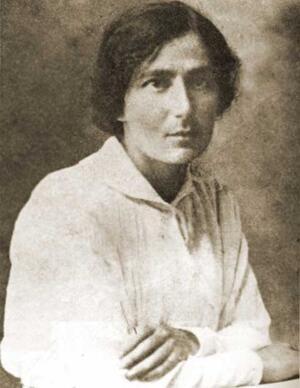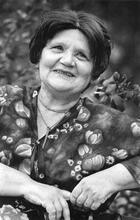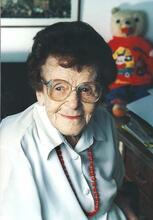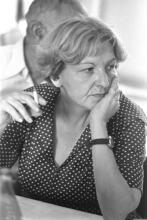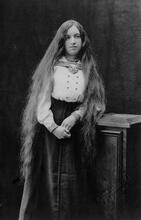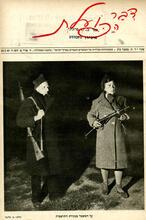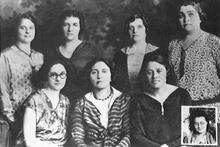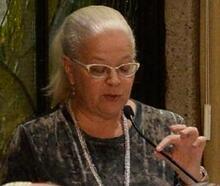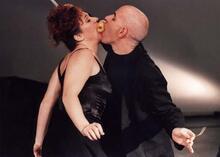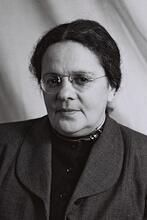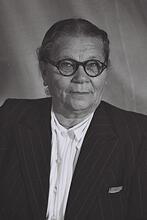Prose Writing in the Yishuv: 1882-1948
The three generations of female Yishuv writers have often been ignored in discussions of Jewish literature from the period. Their work spanned every genre, such as political writings (generally about socialism), children’s books, poetry, and novels. The migration to pre-state Palestine around the turn of the twentieth century helped women writers receive attention for their work, and the number of women writers increased. But, as the sometimes-melancholy tone and escapist themes of their writing show, these women struggled to escape the margins in pre-state Palestine, especially in the patriarchal Zionist movement. Nonetheless, the works of these female writers offer important insights into the lives of Yishuv women and paved the way for contemporary women writers.
Selection of Yishuv Writers and their Work
An examination of the historiographies of Hebrew literature during the pre-State (Jewish community in Palestine prior to the establishment of the State of Israel. "Old Yishuv" refers to the Jewish community prior to 1882; "New Yishuv" to that following 1882.Yishuv) period in Palestine (1882–1948) yields little discussion, mapping, or classification of the gamut of women writers who authored works of prose during this period. The first anthology of Yishuv literature (Mivhar ha-Sipur ha-Erez Israeli [A selection of literature from pre-State Palestine], edited by Raphael Patai and Zvi Wolmut) was published in 1938, with an introduction summarizing the corpus of Hebrew prose written in Palestine, its accomplishments, and the ways in which it differs from Hebrew prose composed in the Lit. (Greek) "dispersion." The Jewish community, and its areas of residence, outside Erez Israel.Diaspora.
Professor Joseph Klausner, who wrote the introduction and who was among the leading scholars and chroniclers of Hebrew literature at the time, described this corpus as follows: “Some thirty writers (unfortunately, only two of them women) have been gathered in the present collection.” One must ask why only two women writers (Devorah Baron and Batya Kahana, 1901–1979) were included, when a glance at the body of contemporary women’s literature reveals an impressive list of novels and short-story collections authored by women, including: Bi-Yehudah ha-Hadashah (In the new Judea, 1911) and Ba-Kefar u-ba-Avodah (In the village and at work, 1930) by Nehamah Pukhachewsky; Sipurim (Stories, 1928) and Simta’ot (Alleys, 1929) by Elisheva Bichovsky; Hayyim (Life, 1929) by Dora Avrahamit; Pirpurei Mahapekhah (Stirrings of revolution, 1930) by Rivkah Alper (1902–1958); Al Saf ha-Mavet (At death’s door, 1936) by Sarah Gluzman (later Gluzman-Gross, 1915–1988); Maria (1932) by Shoshana Shababo (1910–1992); Mephisto (1938) by Miriam Bernstein-Cohen; Mezayefei ha-Hayyim (Counterfeiters of life, 1937) by Miriam Tal; Li-Shenatayim: Roman Bli Ahavah (For two years: A loveless affair) and Be-Darkhei Neikhar (Along foreign paths, 1938) by Rokhl Faygnberg-Imri; Gimnazistit ve-Od Sipurim (A high-school girl and other stories, 1938) by Shulamit Klugai (1890–1972); Parparim (Butterflies, 1927), Bi-Froah Ez ha-Hadar (When the citrus tree blossoms, 1931), and Elbonot (Insults, 1936) by Batya Kahana; and Sipurim (Stories, 1927) and Ketanot (Small things, 1933) by Devorah Baron.
The above relates solely to women’s prose published in book form and does not take into account the veteran writers and the newcomers whose stories were to be found in Hebrew periodicals in Palestine and abroad, in weekly literary supplements, and in assorted collections: the short stories of Hemdah Ben-Yehudah that appeared in Hashkafah, Luah The Land of IsraelErez Israel, Ha-Ivri, and Ha-Toren; Yehudit Harari (1885–1979) in Ha-Omer and Bustanai; Ira Jan in Ha-Or and Ha-Po’el ha-Za’ir; Yona Rigai in Haaretz; Bracha Habas and Penina Kaspi (Mendelson) (1916–1993) in Davar, Emma Levine-Talmi and Sara Levi (later Sara Levi-Tanai) in Davar and Devar ha-Po’elet, Yehudit Mensch (1901–1972) in He-Atid and Shoshana Sherira (1917–2003) in Gilyonot. All of the above published their work in the 1930s.
To these must be added the women who wrote and published during the following decade, including: Ora Zonenschein (later Shem-Or), Hayyai Yathilu Mahar (My life begins tomorrow, 1942); Rachel Adiv, Ohalim ve-Bayit (Tents and home, 1944); Miriam Schneid, Roman be-Mikhtavim (A novel in love letters, 1949); Ella Berglass, a collection of stories in the periodical Gazit, volumes 4 and 5 (1941–1944); and Yehudit Hendel, appearing in Mi-Bifenim (1942) and Haaretz (1946–1948).
Like Joseph Klausner, who in his historical-literary mapping omits the women’s prose created in the Yishuv, so too do other literary scholars, such as Fishel Lachower (Rabbinic authorities/halakhic decisors/ biblical commentators of the mid-11th to mid-15th c.. The period of the rishonim followed that of the geonim and preceded that of the aharonim.Rishonim ve-Aharonim [First and last, 1935], Al Gevul ha-Yashan ve-he-Hadash [Where old meets young, 1951]); Aharon Urinovsky-Ben Or (Toldot ha-Sifrut ha-Ivrit ha-Hadashah [History of modern Hebrew literature, 1946] and Toldot ha-Sifrut ha-Ivrit be-Dorenu [History of contemporary Hebrew literature, 1951]); and Avraham Shaanan (Ha-Sifrut ha-Ivrit ha-Hadashah li-Zerameha [Schools of modern Hebrew literature, 1967]).
Reception of Women in Yishuv Literature
The unique, canonical works of Devorah Baron are familiar to all—and rightfully so. But what of the other women authors? Gershon Shaked, in his innovative historiography encompassing one hundred years of Hebrew prose (Ha-Siporet ha-Ivrit, 1880–1980 [Hebrew prose, 1880–1980]), addresses every male writer, even the most minor. Unlike his predecessor, however, he chooses to devote a brief discussion to two female writers in addition to Devorah Baron, who are presented in a “comparative study” alongside their male counterparts: Nehamah Pukhachewsky with Moshe Smilansky, and Shoshana Shababo as an addendum to Yehudah Burla. While the names of certain women writers, such as Sarah Gluzman, Batya Kahana, Miriam Bernstein-Cohen, and Shoshana Sherira, are mentioned in various periodicals referred to by him in passing, they remain nothing more than names.
This omission calls for further investigation, for not only has male scholarship marginalized women’s prose as part of pre-State literature, but the literary community (i.e., the writers, editors, and publishers of the Yishuv), in which men were the decided majority, did little to foster the creative efforts of women; only in scattered, random instances did the latter find assistance and recognition. Thus, the question naturally arises: How did women’s prose nevertheless make its way onto the bookshelves of the period? One must mention, at this juncture, one of the key disputes preoccupying the literary community at the time, revolving around the question of normalizing the literature of the new country as an integral part of the process of normalization of the people in the transition from Diaspora to the homeland. The subject of the role and contribution of women’s writing to the promotion and normalization of a society of readers also arose in this context.
Since the Jewish Enlightenment; European movement during the 1770sHaskalah, the Jewish reading public had enjoyed access to fine Hebrew literature that appealed to an elite audience. From its first appearance in the nineteenth century, secular Hebrew literature in both the Diaspora and later in pre-State Palestine set for itself poetic standards that aimed at the canonization of literature, but not in its popular form. During this formative period (in particular, between the two World Wars), when the Jews of the Yishuv were seeking to redefine their nationality as an Erez Israeli identity, culture, and ethos, there were those who favored diversifying the nascent Hebrew literature into a more comprehensive body of works aimed at a broader public—that is, also to publish original popular literature such as detective novels, thrillers, adventure, and love stories, alongside canonical works of quality.
The publication of romantic novels (written at the time by men under female names such as H. Shunamit) naturally called attention to the role of women in producing plots that were emotional, soft, and obviously dramatic and that could captivate a broad segment of the female reading public. In other words, even if this debate focused on women’s writing from a stereotypical perspective (since not every woman writer was interested in writing a romantic novel), it nonetheless created a narrow crack of awareness and openness to the possibility of accepting prose written by women.
Male Reactions to Female Writers
Especially noteworthy in this context are the actions of Asher Barash who, as a writer and editor at the Mizpeh publishing house, provided a platform for women’s prose as part of his stated policy of encouraging young artists, both male and female. In fact, the works of Rivkah Alper, Shoshana Shababo, Batya Kahana, Miriam Bernstein-Cohen, Miriam Tal, and others were edited and published by him.
It should also be noted that there were a number of leading male authors who deviated from the general consensus and took a woman writer under their wing. A good example of this is the writer and poet Avigdor Hameiri, who assisted a young writer by the name of Miriam Tal Hameiri, a major writer of the 1930s; Hameiri not only helped to get her first book, Mezayefei ha-Hayyim, published but also wrote an introduction to it, an “advance review,” in which he warmly recommended the novel and described what made it innovative and special: “It is blessed with three qualities that not every first work can lay claim to: it is genuine, candid and tragic.”
In addition, Hameiri stressed the fact that the work was written by a woman and welcomed her as part of the young “reinforcements” who could bring new life to the old literature. As he wrote, free of any gender bias: “A new name. A new writer. The appearance of a new Hebrew creative force stimulates us in a pleasant, intense way. Anyone who has fought in a war knows what it means to hear in the trenches: ‘Fresh forces have arrived!’ or ‘A new squadron has come!’ or even just ‘A newcomer!’” Needless to say, others were not swept up by his enthusiasm and remained largely indifferent; his fellow writers and critics barely reacted and wrote no reviews, either favorable or unfavorable. The same held true with the works of Kahana, whom Klausner sought to promote, and Shoshana Sherira, who was frequently published by Yizhak Lamdan in his periodical, Gilyonot.
The fact that the women writers were ignored by the male literary community placed them in the contradictory position of being both “present” and “absent.” On the one hand, they wrote, published, and expressed their opinions in literary outlets of one sort or another; yet at the same time, the fact that their work was disregarded had the effect of stifling and obliterating them. Angela Ingram, editor of Women’s Writing in Exile (1989), argues in her Introduction that there is actually an advantage to the marginalization of women writers, in that their presence on the sidelines (or as she terms it, their “metaphoric exile”) creates a territory of their own, in which the writing itself becomes a free and independent “home” or living space, from which it is possible to engage in a discourse with the patriarchal literary hegemony in a more unrestrained and decisive manner. Indeed, it is from this literary hinterland that the women writers of the Yishuv made their voices heard, both individually and collectively.
Yishuv Audiences
What sort of literary alliances did the women form? It is necessary at this point to clarify, however briefly, the sectorial-ideological structure of the Yishuv at the time, in keeping with which we can also distinguish between the various groups of women writers. The Yishuv was divided into two major camps: the labor sector and the “civil” sector (used here in the sense of the general, non-labor public). The Zionist-socialist sector encompassed the labor movement with its assorted subgroups (moderates, activists, and radicals), while the civil sector reflected the gamut of Zionist belief (excepting the socialist stream), with its varying degrees of democracy: the moderate right, the progressives, the extreme right and the unaffiliated.
In addition to these sectors there was the religious-Zionist sector, which produced such women writers as Malka Shapira and Penina Kaspi. Although it constituted a partisan body of its own, this sector was divided ideologically into a civil oriented bloc (some of whom were traditional, in terms of religious observance) and a labor oriented one (Ha-Po’el ha- Lit. "Eastern." Jew from Arab or Muslim country.Mizrahi). The latter division applied to the Descendants of the Jews who lived in Spain and Portugal before the explusion of 1492; primarily Jews of N. Africa, Italy, the Middle East and the Balkans.Sephardic Jewish community as well. Shoshana Shababo, who came from a Sephardic family in Safed and grew up in the Lit. "village." The dominant pioneer settlement type of the Jews in Palestine between 1882moshavah of Zikhron Ya’akov, belonged to the civil bloc, and also published in its press; not so the young women writers of Yemenite origin, such as Sara Levi-Tanai and Yona Wahab, who published their first stories in Devar ha-Po’elet and were in fact affiliated with the labor bloc.
Women-Led Publications
The women writers, alone or in groups, also made their voices heard in magazines intended for women, which made their first appearance in the 1920s and were sponsored by both labor and civil organizations. These publications were devoted chiefly to social issues (the role of women in the Yishuv community and the improvement of their status), but they also devoted space to sections on literature, the arts, critical reviews, etc., creating an outlet for women’s writings and thus encouraging new writers.
The first magazine, Ha-Ishah, edited by Hannah Helena Thon, was published in Jerusalem from 1926 to 1929. Sponsored by the Women’s Zionist Organization of America-Hadassah and the Histadrut Nashim Ivriot (Hebrew Women’s Organization, founded in 1920), it represented the civil bloc. Due to its brief existence, the magazine did not manage to establish a literary entity of its own. Its guiding principle was non-partisan support for the suffragist movement, leading it to publish women writers from both the Left and the Right, such as Rahel from the labor sector and Elisheva Bichovsky and Nehamah Pukhachewsky from the civil sector.
Another women’s magazine was Devar ha-Po’elet, edited by Rahel Katznelson (later Shazar) and supported by the Histadrut General Federation of Labor (founded 1920) and the Council of Women Workers (1930). The magazine generally focused on such issues as the status of women and their advancement in Palestine and worldwide, believing that, with the establishment of a truly socialist regime, the questions of women’s oppression and their secondary status would automatically be resolved.
Devar ha-Po’elet, unlike Ha-Ishah, did not publish writers from the civil bloc but only from labor women’s circles. Katznelson also established a literary policy that gave rise to a women’s poetic of its own; on the one hand, she encouraged every reader to write her own story and express herself and her place in the pioneer movement (most of the women would sign their contributions with their first name or their initials), while on the other, she held back women with creative potential in belles lettres by directing them towards documentary, biographical, historical, and autobiographical/memoir writing as an obligation to their generation. Indeed, the group of women that formed around the magazine were known for documenting the country’s projects, legal and illegal immigrations, tribes, institutions (primarily educational), and leaders. These women included Bracha Habas, Rahel Yanait Ben-Zvi, Devorah Dayan, Mania Shochat, Rivkah Alper, Rivkah Gurfein, Emma Levine-Talmi, Kesenia (Zilberberg), and Rahel Katznelson herself. The work of these writers naturally reverberated more strongly with the public, both as a result of their ties with the labor press in both city and A voluntary collective community, mainly agricultural, in which there is no private wealth and which is responsible for all the needs of its members and their families.kibbutz (Davar, Mishmar, Ha-Po’el ha-Za’ir, Mi-Bifenim, and the like) and due to the themes they chose, which emphasized the achievements of pioneer socialist society and its leadership. In fact, to the extent that women writers made an important contribution to the documentary and biographical literature of the period, it was partly thanks to this group.
Olam ha-Ishah appeared later (1940–1948) as a bi-weekly edited by Dr. Rachel Lifschitz and supported by the Women’s International Zionist Organization (WIZO). It too represented the civil bloc, serving primarily as a companion during the dark days of World War II (the magazine provided information on women’s experiences on the home front and in battle [in the British Army], practical and emotional advice for wartime, and sections devoted to literature and culture). Due to its brief existence, there was no group of women writers who coalesced around the magazine, although women from the civil sector, who had already published books of their own and were known to the public (such as Miriam Bernstein-Cohen and Shelomit [Frida] Flaum), contributed to the aforementioned sections.
Groups of Female Yishuv Writers
Despite the divisions in Yishuv society, women’s prose from this period comes across as a unified entity, meaning that even if the writers of Ha-Ishah and Olam ha-Ishah were not always personally acquainted, and even if the writers of Devar ha-Po’elet stayed within their own circles, their common condition of marginality or “metaphorical exile” brought them together, inadvertently, into an “imagined community” of women writers (see B. Anderson, 1983). In other words, even if each of the women lived in her particular surroundings, within her Zionist or Zionist-socialist world, and had a personal affinity for this or that school of literature, there was still a feminine, experiential connection that was forged—one that was jointly imagined by all of them. This connection found a common expression with varying doses of feminine meta-politics (to which they were connected ideologically and practically, whether consciously or unconsciously) and varying measures of feminine meta-poetics (in terms of which they recounted the pre-State reality, thematically and esthetically).
Accordingly, even though the present discussion encompasses a period of sixty-six years of women’s prose (1882–1948), the writers are presented here as one literary meta-group—a group that warrants a generational classification of its own, as distinct from the customary categories of men’s prose of the pre-State period, with its various schools and groupings (see for example, Shaked 1997). What follows are the three generations of women’s prose.
The first generation consists of women born in the latter half of the nineteenth century, who immigrated to pre-State Palestine in the late nineteenth and early twentieth centuries and began publishing during this period, including: Nehamah Pukhachewsky, Hemdah Ben-Yehudah, Yehudit Harari, Devorah Baron, and Ira Jan. This group also includes Shulamit Klugai and Miriam Bernstein-Cohen, who began to publish in the 1920s, and Hannah Luncz (later Bolotin) (1892–1987), who was born in Palestine.
The second generation encompasses women born in the first decade of the twentieth century, who immigrated to pre-State Palestine in the Third (1919–1923) and Fourth Lit. "ascent." A "calling up" to the Torah during its reading in the synagogue.Aliyahs (1924–1928) and began publishing during this period: Batya Kahana, Yehudit Mensch, Rivkah Alper, and Emma Levine-Talmi, as well as Shoshana Shababo, who was born in Palestine.
The third generation includes women born between roughly 1915 and the 1920s, who were brought to Palestine at an early age and were raised there as if native-born. They began to publish in the 1930s and 1940s, and included Ruhama Hazanov (1912–1994), Sarah Gluzman, Shoshana Sherira, and Penina Kaspi.
The Female Yishuv Writing Community
What is the nature of this women’s prose, and what sets it apart as an imagined literary community of its own? If we examine the process of acculturation experienced by Jewish women in the early nineteenth century (western Europe) and the mid-nineteenth century (eastern Europe), it emerges that as women were directed toward educational frameworks of one type or another (whether a private tutor at home or various school settings), a desire to express themselves through writing awakened in them. But the creative process is “public dependent” (Sartre 1949); and since the Jewish society of the Haskalah period, despite its pretensions of liberalism, rejected women writers, and even related to them as freakish or amusing—a hybrid that was neither man nor woman (witness the responses to the works of Rachel Morpurgo and Sarah Feiga Meinkin Foner)—they were forced to silence themselves and even to destroy their work (Feiner 1993).
This behavior underwent a total transformation with the immigration of women to Palestine. As early as the First Aliyah (1882–1904), one encounters women writers who not only do not hold themselves back but who go forth to demand the education of women (Nehamah Pukhachewsky 1889) and eventually even become leaders and spokespersons of their national revival (Ben-Yehudah 1919). For women writers, then, the national revival in pre-State Palestine represented a revitalization both of women and of literature. And even if in Palestine, as in the Diaspora, they were surrounded by a hostile male environment—both the conservative circles (the religious Zionists, who thwarted any effort to grant rights to women) and the progressive circles (the workers who waved the banner of equality, but not for women)—they did not retreat, nor did they keep silent.
On the contrary, the longing for a female resurgence, as well as the national and the literary revivals, only grew stronger during the ensuing waves of aliyah. This desire is reflected in taking on broader and more practical dimensions in the form of women’s organizations, in which the women writers were well represented. Other noteworthy organizations, in addition to those cited above, included The Assembly of Women Workers (first held in 1911), The Union of Hebrew Women for Equal Rights in Erez Israel (1919), WIZO (1920), and The Council of Religious Women (1935).
Undoubtedly, for women the move from the Diaspora to the homeland constituted a transition from absence to presence, from silence to a voice of one’s own. And even if the woman writer in Palestine did not find encouragement but was shunted to the social and literary fringes, she nonetheless insisted on committing her work to paper. Thus, one can trace the development of women’s prose to the beginnings of the Jewish renewal in Palestine; and it continued to be written with perseverance and consistency, expanding in scope as time went by.
Women’s prose during the First and Second Aliyahs began with seven or eight women writers, and by the 1930s and 1940s there were already several dozen. In addition to these women, there were many authors of children’s books, such as Yemima Tchernovitz, Bella Baram, Rivkah Gurfein, Malka Fishkin, Shoshana Appelbaum. There were also playwrights, including Yona Rigai, Miriam Bernstein Cohen, Rachel Adiv, and Shulamit Bat-Dori, not to mention the poets Rahel, Elisheva Bichovsky, Esther Raab, Lea Goldberg, Anda (Pinkerfeld) Amir, Yocheved Bat-Miriam, Zelda Shneurson (Mishkovsky), Yaffah Krinkin, Miri Dor, and Chaya Vered. The children’s poets (Fanya Bergstein, Miriam Yalan-Stekelis, and Ella Amitan were also part of this group.
In addition, there were women who wrote in a variety of genres; their works, while not necessarily fine literature, help enhance the discussion and the study of intermediate writing between documentary and literary. These included essayists (Hannah Helena Thon, Rahel Katznelson, Ada Maimon, Geulah Raphael, Malka Shapira); columnists (Lilia Bassewitz, Hannah Chizhik, Adina Kahansky, Tamar Bukhstav); literary critics (Rivkah Gurfein, Kesenia, Tamar Dolzhansky, Ita Faktorit); writers of articles, memoirs and autobiographies (Elisheva Bassewitz, Ita Yellin [1868–1943], Sarah Malkhin, Shelomit Flaum, Henia Pekelman, Chaya Weitzman Lichtenstein, Devorah Dayan); and biographers (Hemdah Ben-Yehudah, Hannah Luncz, Bracha Habas, Rahel Yanait Ben-Zvi, Mania Shochat).
Motivations for Writing
Thus, the portrait that emerges is one of a vibrant and active community of women who wrote, read, and responded, which raises the question: What motivated these women to write and to narrate? From where did they draw the assertiveness necessary to write? And in particular, what gave them the strength and the courage to direct their limited free time to this endeavor, amid the constraints of daily existence? Whether under a crumbling Turkish regime, a distrustful Mandate for Palestine given to Great Britain by the League of Nations in April 1920 to administer Palestine and establish a national home for the Jewish people. It was terminated with the establishment of the State of Israel on May 14, 1948.British Mandate, or the constant threat of the Jewish-Arab conflict, the entire existence of the settlement enterprise, both economically and in terms of security, had always been precarious.
In this impossible reality, the women writers found themselves coping on a daily basis with the difficulties of work, livelihood, birth, child-rearing, and homemaking (and all this, amid the most minimal living conditions and primitive technology, in both villages and cities). Over and above all this, they were coping with the Hebrew language, with which they were not yet comfortable, coupled with an unsupportive literary hegemony and the growing absence of sources for discourse and cognitive stimulation, such as the newest in world literature, modern artistic performances, or foreign newspapers.
As for the question of what motivated them, there are a number of answers:
I. Writing is, first and foremost, presence—a presence of strength. Thus, women sought, through their writing, to make their presence known in the Yishuv—in the fateful historical circumstance of the modern-day Return to Zion and the relentless struggle to carve out a new life in Palestine. An examination of the lists of pioneers in Sefer ha-Yovel Zikhron Ya’akov (Jubilee volume of Zikhron Ya’akov, 1943), for example, does not reveal even one woman’s name (likewise, the list of the founders, the fallen, the ones who left, nor the ones who stayed on despite it all and raised a new generation of builders). In other words, based on these lists, one might think that women took no part in the founding and building of Zikhron Ya’akov. So too with other volumes of this type, not to mention countless documents, including certificates, letters, protocols, and the like. Accordingly, there is no doubt that women’s writing in the Yishuv period was an impressive instance of empowerment, a statement that “we are here”; their work not only fills in the missing pieces of the history of Hebrew literature in Palestine but provides extensive and varied information about life in the country, particularly the daily life of women.
II. A second motivating factor is the determination of the women writers to tell their story in their own voice. It seems that in Palestine they were no longer willing to have a male writer mediate between them and their public, portraying them, their characters, their life story, their experiences, according to his own interpretation (as had hitherto been the case in the literature of the Haskalah and Lit. "love of Zion." Movement whose aim was national renaissance of Jews and their return to Erez Israel. Began in Russia in 1882 in response to the pogroms of the previous year. Led to the formation of Bilu, the first modern aliyah movement.Hibbat Zion). Consequently, from the outset, they enlisted every literary device, on every level, in the struggle to frame a creative world of their own—a world in which they are the ones who structure their narrative space, the contours of their characters, and the discourse on their attitudes and perceptions.
III. The women writers chose to speak of their Land of Israel, not only through the prism of their own world but also from other perspectives that disclose a whole spectrum of characters, some of them silent and subdued, incapable of expressing their struggle as women, as wives, as mothers. This resulted in a wealth of portrayals of women and, consequently, a multitude of voices (a quality not found in men’s prose, which tended in the Yishuv as well to stereotype female characters).
This is true of Nehamah Pukhachewsky, who devotes a major portion of her work to presenting the voice of Yemenite women in Rishon le-Zion; so too, Hemdah Ben-Yehudah, whose writing embraces both ultra-Orthodox Jews of European origin and their descendants, including most of North and South American Jewry.Ashkenazi women and their Sephardic sisters, in both the Old and the New Yishuv of Jerusalem; and Sara Gluzman, who reveals the story of the hungry, unemployed women workers in the elegant “White City” of Tel Aviv. Emma Levine-Talmi draws us into the intimate world of women pioneers in the labor brigades of the Third Aliyah, performing the back-breaking labor of paving roads and draining swamps between Haifa and Nahalal. Shoshana Shababo goes even further, providing a voice not only for the community of Sephardic women in Safed but also for the Arab women of the city (Haifa) and the village (Furaydis). Also noteworthy are the unique voices of women in the stories of Penina Kaspi, among them the religious woman, both as factory worker and Cooperative smallholder's village in Erez Israel combining some of the features of both cooperative and private farming.moshav member. Ruhama Hazanov offers us two generations of women farmers in Gedera, while Batya Kahana’s focus ranges from women as artists to women as fighters (in the Haganah underground), from the destitute seamstress to the bored, well-heeled housewife.
This overview would not be complete without one literary figure who was still in the process of emerging at the time—the new, native-born Hebrew woman. While men’s literature was constantly engaged in forging a “new man” who epitomized the settler, the pioneer, the laborer (while still branding the woman with the traditional qualities of the wife, mother, and lover), women’s writing sought to create its own definitive character. This portrait of the “new woman” increasingly drew its inspiration not from the conventional images of lovers and mothers, but from leading biblical figures like Deborah, Miriam, and the daughters of Zelophehad. These models provided a much-wanted guideline to construct the earliest typological outline of the future zabarit (native-born woman) (see Hemdah Ben-Yehudah, Yehudit Harari, Hannah Trager, and others).
IV. Undoubtedly, one of the dominant motivations for women’s writing was the continuing sense of dissatisfaction on the part of nationally aware women with respect to the Zionist movement as a patriarchal, hegemonic masculine enterprise. From the moment they immigrated to Palestine and devoted their lives to building the people and the land, women saw themselves as equal to men, without any gender bias or distinction. Zionist doctrine formulated its message in this spirit (at the First Zionist Congress in Basel, in 1897, women were invited as full and equal delegates). This was also the wording of the Zionist and socialist manifestos studied in the Jewish youth movements in Europe (see stories of female youth-group members, including Pirpurei Mahapekhah by Rivkah Alper, Kokhavim me-al ha-Gan [Stars above the garden] by Rivkah Gurfein and Ne’urim [Youth] by Yehudit Mensch).
As a result, women were justifiably taken aback, upon their arrival in Palestine, to discover the erosion in the perception of woman’s place in society, and the masculinization that had swept the pioneer movement with the male domination of the centers of power in the Zionist, labor, and cultural spheres. In other words, the idealistic woman, who had left her home and family, her studies and her supportive environment, to help realize female-national renewal and independence, felt frustrated and deceived (see the autobiographies of Sarah Malkhin, Henia Pekelman and Tehiya Liberson).
Indeed, until 1926, women in the new Yishuv were denied all rights (including, first and foremost, the right to vote and to be elected). It was only by banding together and stepping forward to claim their rights that they advanced the democratization of Yishuv society; but even after gaining the right to vote in January 1926, women did not cease fighting for their equal place. They found themselves to be not only second-class residents of the new national home but often “homeless” within its confines. This painful national disappointment preoccupied many of the women writers, who repeatedly explored this unexpected male mutation of Zionism, both questioning it and expressing subversive criticism.
V. Among the factors motivating women to write was the fundamental longing to create for creation’s sake, which was unquestionably the basic impetus driving the women to carve out “time for themselves” amid all the daily obligations and constraints. It should be noted that most of the women writers could not allow themselves the rare luxury of being a writer who devoted all her energy to her craft (see the letter of Nehamah Pukhachewsky, 1923): “I am forbidden to dream of vacation and rest. I thought that after the grape-picking, I would be free as a bird, I would fly to some quiet nest to do a bit of intellectual work … but the annoyance of daily events intrudes and shatters these lovely dreams.”
Thus, when speaking of women writers of the Yishuv period one is generally referring to “occasional” writers. There were, of course, those who managed to expand on these “occasions,” within the framework of their ongoing obligations—whether as journalists (Rivkah Alper, Shoshana Sherira, Miriam Tal, Ora Zonenschein) or as teachers (Ira Jan, Ruhama Hazanov, Sarah Gluzman). Some, like Shoshana Shababo, were fortunate enough to find “time to write” while they were single but stopped writing once they married. Miriam Bernstein-Cohen, whose primary occupation was acting, recounts in her autobiography (Ke-Tipah ba-Yam [Like a drop in the ocean, 1971]), how she began writing her first novel (Mephisto, 1938) when the theater where she worked was closed down due to the Arab riots of 1936. Nehamah Pukhachewsky would write during every spare moment and towards evening would saddle a donkey and go out to the vineyards to be alone with her thoughts; Devorah Baron created a remote island of her own amid the bustle of Tel Aviv life, secluding herself in her home and devoting all her time to writing, at the expense of her home, , and social life.
Literary Themes
These shared points of departure can provide an insight into the creative dynamic that animated this imagined community of writers and, of course, into the meta-poetics that produced their work. The following is a brief, illustrative glimpse into the nature of this poetic, touching on such elements as the female thematic display; the national narrative of women; the constructive and the melancholic viewpoints; and marginalization as the source of a different type of writing.
Women’s prose during the Yishuv period focused, for the most part, on the female space, embracing two levels of content: (1) woman as woman (that is, issues of intimacy, sexuality, motherhood, the female body, women’s discourse, women’s friendship, relationships within couples and families, the exploitation of women [sexual harassment], women’s work and livelihood [including all the problems of discrimination and exclusion], childhood, adolescence, old age); and (2) woman in context of the Yishuv community, or, what it means to be a woman in pre-State Palestine (the transition from Diaspora to homeland and from conservative to liberal patterns of behavior, the encounter with the Land, conflict between various Jewish ethnic groups, cross-gender work concerns, tension between the individual and the group, the absence of an extended family, and the national revival as a female resurgence).
Needless to say, this feminine thematic scheme also contributed to the creation of a national narrative of its own. The question is: in which scenarios did women writers choose to formulate such a narrative for themselves, and in what way did they recount this narrative by means of their plots, characters, and statements? It should be noted here that the meta-poetics of women offered a national narrative that was separate and distinct from that of the men—one whose story lines were marked not by dramatic struggles between success and failure (what Gershon Shaked terms “the literature of the homeland”) but by the routine, unassuming existential story of a society surviving from day to day. In other words, the male national narrative proclaimed itself as the standard-bearer, reasserted the founding principles, and amplified every ordinary event (such as working in the field, a night spent on guard duty, or a trek through the country) into a heroic historical statement (“one cannot conquer the mountain without graves along the way”).
Not so the female national narrative, which delved more deeply into the personal and the particular; it treated the individual environment as a communal test case—an opportunity to seek, to question, to explore what the Land of Israel was for them. Thus, if the male narrative stressed “conquering the mountain” as a totality, the female narrative pointedly rejected the “heroic sagas” and “spoils of battle” in favor of gradual minor progress and the attitude of “only a path have my feet paved,” “only a tree have my hands planted” (in the words of the poet Rahel).
An examination of the national narrative of the women writers from the First Aliyah onward reveals two distinct “feminist” positions: the first is the constructive view introduced by Hemdah Ben-Yehudah, and the second, the melancholic view, first seen in the work of Nehamah Pukhachewsky. Ben-Yehudah’s work depicted the secondary, marginal status of women in Yishuv society of the early twentieth century as a transient phenomenon that could be improved through suitable education and national awareness; thus, even if her national narrative exposed the exploitation and oppression of women in a male society (“Lulu”) and in fact denounced it, it always hastened to reassure the reader that the situation would ultimately be corrected and to conclude with a rosy vision of the future. This optimistic feminism also created alternative scenarios involving models of the ultimate Yishuv woman who stands out by virtue of her opinionated, independent nature, remaining unbowed in the face of the all-powerful Zionist male (Tahat ha-Shaked [Under the almond tree], Simlah Hadashah [A new dress], Ba-Moledet [In the homeland]). While these examples are works of literature, they also serve as a constructive guide to the development of the new woman in pre-State Palestine.
The melancholic view is more realistic and at the same time more critical. According to this perspective, the Zionist enterprise (which was a male undertaking, as stated above) failed to implement the moral and ethical values that were supposed to be realized in Palestine with the restoration of Jewish society to its homeland and the attempt to create a new land, a new people, a new individual. On the contrary—this Jewish society only repeated earlier misdeeds and perversions, revealing itself to be a reactionary society that perpetuated social gaps and developed an insensitivity to the downtrodden (workers, women, and other ethnic groups).
This view is apparent from the outset in the works of Pukhachewsky, who prefers to present her national narrative from the perspective of the weak, exposing their dismal situation with a critical, clear-eyed realism that is, at the same time, bleak and melancholic. While Pukhachewsky also portrays a hired laborer and a Yemenite Jew, her primary concern is the oppression of women. Whether Sephardic or Ashkenazic, women are always presented as victims, if not doubly so—victims of a male member of the family (husband, brother, brother-in-law, etc.; see “Sarah Zarhi,” “Ha-Meshek” [The farm], “Rumah,” and victims of a chauvinist, male-dominated society that adopts demeaning behavioral codes towards women, like the male society of the moshavah (see Bi-Vedidut [Lonely]), or of an ethnic group, in this case the Yemenites, in Aharei Simhah (After celebration) and Asonah shel Afyah (The tragedy of Afyah).
Pukhachewsky’s melancholic view was often poorly received by the critics. In the review of her book Bi-Yehudah ha-Hadashah (1911), Ya’akov Zerubavel (1886–1967) attacked her for the prevalence of sickness and bereavement in her stories, and Gershon Shaked in his historiography (1983) argued that her writing was melodramatic and aimed only at “evoking pity and drawing tears.” It appears that these critics did not plumb the depths of her ambivalent text; rather than seeking to be a perfect mirror of reality, it stands as an act of protest by a woman artist who, using melancholy as a device, undermined the Zionist and literary consensus and shattered the national narrative of the heroic male (which had captivated the public), replacing it with an alternative narrative of her own.
This subversive literary device spans fifty years and three generations of women’s writing, demonstrating that it is not in fact the constructive view but the melancholic one (in varying degrees) that dominates this literature. For example, in the work of Sarah Gluzman (the second generation), Tel Aviv is not a gleaming “white city” rising from the sands but a sullen and oppressive place for its workers and pioneers (Al Saf ha-Mavet); or Ruhama Hazanov who, of all the possible family histories in a flourishing moshavah, places at the forefront of her novel Gederot (Fences) a family that came to “build and be built” and finds itself burying its sons and daughters, one after another. Likewise, Devorah Baron, of the first generation (Ketanot, Mah she-Hayah [What was]); Yehudit Mensch (Ne’urim) and Batya Kahana (Elbonot), of the second generation; and Shoshana Sherira (Almanot [Widows], Lev Navokh [Confused heart]) and Miriam Tal (Mezayefei ha-Hayyim), of the third generation. An atmosphere of intense sadness emanates from these works, not to mention those of Penina Kaspi, in which anger and depression produce such disturbing stories as “Shuna,” “Zelalim Melavim” (Accompanying shadows), “Ha-Ahot Na’omi” (Sister Naomi).
There is no doubt that this strategy could only have emerged from those same literary margins to which the woman writer was consigned, for it was precisely these margins that afforded her an advantage by releasing her from any sense of obligation, self-negation or the need to pursue important groups or fashionable schools of thought. Thus, without any binding models and without the fear of “influence,” “acceptance,” “demands of expectation,” and the like, it became possible for women to create literature freely and independently, on both the intellectual/political and emotional/intuitive levels. Indeed, the “poetics of the margins” offered a form of women’s art that was different—in content, genre, and language. For example, it was only after Devorah Baron placed herself “on the fringes” that she felt freer to transgress the established literary imperative that utterly negated the Diaspora and to continue treating the religious and Diaspora-centered themes of the Lithuanian Jewish (Yiddish) Small-town Jewish community in Eastern Europe.shtetl (Parshiyot [Affairs]).
No less daring was the position taken by Shoshana Shababo who, at the height of the Jewish-Arab conflict and the Yishuv’s struggle for Palestinian land, chose to tell a story of an Arab family and in a lengthy novel spread over two volumes (Maria). Miriam Tal (Mezayefei ha-Hayyim) and Ora Zonenschein (Hayyai Yathilu Mahar) [My life will begin tomorrow] perverted the portrait of “the new Jew,” no longer depicting him as the ideal symbol of a new life in Palestine but as a grotesque subject of ridicule, in the person of a wily merchant (or official) who perpetuates the Diaspora in the homeland.
Batya Kahana goes even further, placing the “new Jew” in a romantic contest against two rivals/adversaries—the native-born Arab (Ha-Hitzim Mimkha ve-Hal’ah [The arrows are beyond you]) and the anti-Zionist Jew (Bi-Froah Ez ha-Hadar [When the citrus blooms])—who compete for the heart of the Jewish woman of the Land of Israel and even succeed for a while.
As with subject matter, so too with genre, yielding the unexpected hybrid of the “national romantic novel.” This genre, which customarily unfolded within the intimate “forbidden” space between an innocent young girl and a compelling stranger, is situated between the “intimate” and the “national,” combining the consummation of a love affair with Zionist messages (Bi-Froah Ez ha-Hadar by Batya Kahana, Roman be-Mikhtavim by Miriam Schneid, Hayyai Yathilu Mahar by Ora Zonenschein).
An additional genre is the woman’s fantasy, which stood out as “different” against the backdrop of the realistic, naturalistic male story in the early decades of the twentieth century (examples include Parparim by Batya Kahana and “Ha-Nasikh Ba’al Shesh ha-Ezba’ot: Rishmei Masa” [The six-fingered prince: Impressions of a journey], by Penina Kaspi). These fantasies, which tended to paint the grim reality of Yishuv life in rosy hues, were presented in the form of collective national yearnings (Hemdah Ben-Yehudah), but this genre could also portray reality as a horrific apocalypse through the use of surrealistic allegory (Ira Jan).
As for the language complex in the writings of the women authors, here too there is an unmistakable difference between female and male linguistic stylizations. The Jewish male encountered the Hebrew language as an integral part of his education in the Diaspora (the heder and the yeshiva); not so the Jewish woman, who was introduced to Hebrew only if she joined the Zionist youth movements of the Diaspora, and of course upon settling in Palestine (with the exception of writers such as Devorah Baron and Nehamah Pukhachewsky, who had studied Hebrew from childhood, and writers born in Palestine). Over time, however, the attitude toward their use of language has shifted; the male text of the Yishuv period, which stood out for its lexicographical torrent of description and variety, is now perceived as outdated and cumbersome; on the other hand, the text of the women writers not only flows better but its style comes across as modern and relevant.
Conclusion
One cannot address women’s literature of the Yishuv era without exploring the connection between the pre-state years and the period following the establishment of the state, in particular the growing number of works produced by women from the late 1980s onward. Indeed, the question has been raised in recent years of whether it is possible to speak in terms of the chronological development of women’s literature from the First Aliyah to the present, or whether women’s literature from the Yishuv years remains an entity unto itself, limited to its period. When the first volume of Gershon Shaked’s historiography (Ha-Siporet ha-Ivrit, 1880–1980) appeared, Amos Oz stated that he saw the biography of the male literary community as the lineage of one family, with its fathers and sons, its close and distant relatives.
But what of the literature produced by women? Given the neglect of the women writers of the Yishuv—a fact that prevented generations of women from growing up on them and their writings—is it still possible to speak of a link between the women writers of the pre-State period and those from the establishment of the state to the present? The answer lies in the implied poetic connection that emerges from their work; for it is clear to anyone who examines their writing that even if the later writers were not acquainted with their predecessors, the same meta-poetic permeates their work. For instance, the melancholic view continues to pervade the writings of Judith Hendel, Rachel Eytan, Nurit Zarhi, Leah Eni, Mira Magen, and Lily Peri-Amitai.
The thematic construct of “homelessness at home” lies at the core of the novels and short stories of Ruth Almog, Shin Shifra, Ronit Matalon, Orly Kastel-Bloom, and Daniella Carmi. Shulamit Lapid writes historical novels about the early days of the Yishuv that hark back to the Yishuv novels of Rivkah Alper. Dorit Rabinyan and Shifra Horen offer a colorful, sensual “eastern” women’s life, as if engaging in a dialogue with Shoshana Shababo. Hemdah Alon, Hadara Lazar, Semadar Hartzfeld, and Joceline Carmi-Amir continue to be preoccupied with the character of the alien lover as Arab male, linking them—consciously or unconsciously—with the work of Batya Kahana.
What has changed—and most significantly, at that—is that the contemporary women writers are achieving a popularity and acclaim that were denied to their predecessors. Their works are high on the lists of best-selling books and they are now more frequently found among those who win significant national awards. Women writers seem at last to have penetrated the mainstream of Hebrew prose and their distinctive voices are reaching a large public of readers, both male and female.
Hebrew:
Berlovitz, Yaffah. “Exploring the Zionist Narrative of Women—Dawn of a Century/Close of a Century.” In Sifrut ve-Hevrah be-Tarbut ha-Ivrit ha-Hadashah, edited by Joseph Bar-El, Y. Schwartz, and Tamar Hess, 421–439. Tel Aviv: 2000.
Berlovitz, Yaffah. “In Search of a Portrait of the ‘Erez-Israel Woman’ in Women’s Literature of the ” In Bikoret u-Farshanut, Kovetz Meyuhad: Ha-Ishah ha-Yisraelit, edited by Tova Cohen, 91–113. Ramat Gan: 2000.
Berlovitz, Yaffah. “Literature from a ‘Lost Continent.’” In She-Ani Adamah ve-Adam: Sipurei Nashim ad Kom ha-Medinah, 319–336. Tel Aviv: 2003.
Berlovitz, Yaffah. “‘Our Time Has Come’: Feminine Identity, Feminine Writing.” In Le-Hamzi Erez, le-Hamzi Am, 49–79. Tel Aviv: 1996.
Berlovitz, Yaffah. “The Voice of Melancholy as the Voice of Protest: A Study of the Writings of Nehamah Pukhachewsky—One of Palestine’s First Women Storytellers.” In A View into the Lives of Women in Jewish Societies, edited by Yael Azmon, 325–336. Jerusalem: 1995.
Berlovitz, Yaffah. “Women as Presented in Women’s Literature of the First Aliyah.” Cathedra 54 (December 1989): 107–124.
Berlovitz, Yaffah. “Women’s Literature in the Yishuv Period: Reorganization of an Excluded Culture.” In Harimi be-Koah Kolekh: Kolot Nashi’im u-Farhshanut Feministit be-Limudei ha-Yahadut, edited by Renée Levine Melammed, 97–121; Tel Aviv: 2001.
Berlovitz, Yaffah. “Women’s Meeting Points in the Early Days of the ‘New Yishuv’ (1878–1918): A Look of their Writings” (‘Al tzomtei mifgashim bein nashim bereishit haYishuv [1878–1918]: ‘Iyun bekitveihen shel rishonot). In Iyunim bitkumat Israel: Gender in Israel – New Studies on Gender in the Yishuv and State, edited by Margalit Shilo and Gideon Katz, 369-408. Sde Boker: 2011.
Berlovitz, Yaffah. “‘My Whole Intention Is to Write to the Extent of My Ability and My Strength’: A Study of the Early Literary Work of Sara Levi-Tanai (1929–1934)” (Kol kavanati hi likhtov lefi yakholti ulefi koḥi). In Sara Levi-Tanai: A Life of Creation (Sarah Levi-Tanai: Ḥayim shel yetzirah), edited by Henia Rottenberg and Dina Roginsky, 59-88. Tel Aviv: Resling, 2015.
Ben-Yehudah, Hemdah. “Our Time Has Come.” Do’ar Hayom, 30.9.1919.
Feiner, Shmuel. “The Modern Jewish Woman: Test Case in Attitudes of the Modern Haskalah.” Zion 4 (Jerusalem 1993): 470–497.
Fogiel-Bijaoui, Sylvie. Eve’s Eyes—the Woman in the Jewish Yishuv in Palestine, 1904–1948. A Summary of a Doctoral Dissertation (University of Paris-X, Nanterre, 1981). Tel Aviv: 1982.
Govrin, Nurit. “‘Nefesh’ mi-Rishon le-Zion Homiyah: Nehamah Pukhachewsky.” In Devash mi-Sela, 114–171. Tel Aviv: 1989.
Guez, Ronit. “Women’s and Men’s Fiction in the Period of the Yishuv: Negotiations over the National Narrative” (Sifrut nashim vesifrut gevarim bitekufat hayishuv: Masa umatan ‘al hanarativ hale’umi). Ph.D. Dissertation, Ben-Gurion University of the Negev, 2011.
Guez, Ronit, “A Gender Re-vision of the Historiography of the Period of the National-Zionist Revival” (Re-viziyah [re-vision] migdarit shel hahistoriyografiyah bitekufat hateḥiyah hale’umit-Tziyonit). Hador: The Hebrew Annual of America, Fall 2016, 117–124.
Isha, Adi, “The Poetics of Disassembly in the Works of Shoshana Shababo” (“Vehayetah hapeli’ah haḥalutzah haḥadashah”: Po’etikat hapeiruk beyetziratah shel Shoshanah Shababo). Israelis: A Bilingual Periodical for the Study of Israel and Zionism 9 (2019): 45–70.
Melman, Billie. “From the Margins to the History of the Yishuv: Gender and ‘Israeliness’ (1890–1920).” Zion 3 (1997): 253–278.
Pukhachewsky, Nehamah. “More on the issue of the female question.” Ha-Meliz, 23.1.1889.
Rattok, Lily. “Every Woman Knows It: An Afterword.” In Ha-Kol ha-Aher: Siporet Nashim Ivrit, edited by Lily Rattok. Tel Aviv: 1994, 272–274.
Rosenberg, Lilach. “Farms of Religious Women Laborers in Erez Israel, 1925–1939.” Cathedra 90 (December 1998): 87–114.
Shavit, Zohar, and Jacob Shavit. “History of the Hebrew Crime Novel in pre-State Palestine.” Ha-Sifrut 18–19 (December 1974): 30–45.
Shavit, Zohar, ed. Building a Hebrew Culture in Pre-State Palestine. Jerusalem: 1999.
Shilo, Margalit, Ruth Kark, and Galit Hazan-Rokem, eds. The New Hebrew Women: Women in the Yishuv and in Zionism From a Gender Perspective. Jerusalem: 2001.
Shirav, Penina. Non-Innocent Writing: Discourse, Position and Female Representation in Works by Judith Hendel, Amalia Kahana-Carmon and Ruth Almog. Tel Aviv: 1998.
English:
Anderson, Benedict. Imagined Communities: Reflections on the Origin and Spread of Nationalism. London and New York: 1983.
Berlovitz, Yaffah. “No Home at Home: Women’s Fiction vs. Zionist Practice.” In Discourse on Gender/Gendered Discourse in the Middle East, edited by Boaz Shoshan, 95–115, 159–161. Westport, CT and London: 2000.
Bernstein, Deborah, ed. Pioneers and Homemakers: Jewish Women in Pre-State Israel. New York: 1992.
Geva, Sharon. "Ahead of its Time: Ha'ishah Bamedinah—The Story of a Forgotten Women's Journal in Israel." Nashim: A Journal of Jewish Women's Studies & Gender Issues 34 (2019): 98-122.
Makov-Hasson, Hadar. “Oedipus’ Sister: Narrating Gender and Nation in the Early Novels of Israel Women.” Ph.D. Dissertation, New York University, 2009.
Sartre, Jean-Paul. What Is Literature? New York: 1949.
Zakai, Orian. “Zion of Their Own: Hebrew Women's Nationalist Writing.” Ph.D. Dissertation, University of Michigan, 2012.

